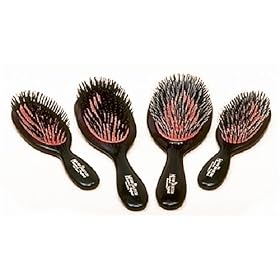
So you may be wondering what the big deal is about the boar bristle brush. You may be asking questions like "Why do stylists insist that I use one?" and "Do I really have to get a Mason Pearson, or at least a Denman?" Believe me, I had to ask those same questions too before I got my brush... and now that I have one, I couldn't be happier.
Now, before you ask me where and how I got my hands on such a shmancy brush, let me disclose here that my brush is nothing like those brand-name ones that the big-name stylists like to brandish at photo shoots. Those brushes will, indeed, cost you for their craftmanship; they're built to last for decades, and are meant to use for both grooming and styling... but they're definitely not for everyone. (Especially not Mason Pearson -- even its "pocket" model is way too much brush for somebody of my stature.) That's why I had to put the asterisk (*) in the title of this entry: If you have wavy or curly hair, you would be able get away with using a stylist-level brush that has the right combination of boar and nylon bristles to help you style your hair as you desire, with or without destroying your natural curl pattern.
That said, if you have board-flat, baby-fine hair like I do, an all-boar bristle brush may very well do the trick.
I say this because my current brush of choice is a $3 all-boar wood-set paddle brush that I bought at Walgreen's. (You can view similar-looking brushes here and here, for slightly more coin.) Before I bought this I was getting tired of the cheap plastic brushes that I have been using on my hair; they were OK with the detangling, but my scalp - and my hair - felt like it was being poked; for all they were worth, I might as well have been styling my hair with a garden rake.
Not so with the boar bristle brushes. For one thing, boar bristles are, of course, made of boar hair - and unlike a plastic or nylon bristle, which is structurally flat on the surface, boar hair has scales that can pick up and redistribute natural scalp oils when used to style or brush through human hair. This concept of redistribution explains several things that I've noticed since I started using the boar brush:
- The incredible amount shine that I've noticed on the surface of my hair;
- The ability of said hair to not only change from a middle to a side part, but to maintain said side part (and/or any other brush-related styling direction) for hours on end;
- The constant, well-conditioned softness throughout every strand; and
- The ability to maintain actual volume on top of the aforementioned shine and softness.
In other words, my boar bristle brush has turned my hair into the living embodiment of a shampoo commercial, without the post-production CGI.
As for the purported scalp-massaging properties of boar bristles, here's my take on the phenomenon: I've noticed that, after several uses, the boar bristles on my brush have been showing signs of splitting and fraying... and while some may take that as a sign of less-than-optimum quality, I say that the frayed ends actually make the brush better and softer, not only in picking up individual hairs from the scalp but also in exfoliating the scalp itself by picking up dead skin cells and other kinds of grunge - thus boosting circulation to the scalp and follicles. That means, when you use a boar-bristle brush on your hair, you're not just raking an instrument up and down your scalp; you're actually sweeping hair and grunge off your scalp with thousands of tiny little brooms, all while redistributing oils down the hair shaft. Who needs a ton of products and hair styling appliances when you can just brush your own hair?
Now, I have to remind you that - as with any brush with fine, tightly-packed bristles - using a boar bristle brush on wet hair is a DON'T: it may be softer and kinder, but it's still a brush, and thus just as likely to rip up weak, wet hair strands. Cleanup is also no joke: I can't wash my brush in the sink because the base is made out of pure wood, so I have to basically clean it by picking out hair strands with a nail file and shaking out the accumulated grunge over a trash can. (Gross.) Sometimes I even spray the brush with a ittle MAC Brush Cleaner to disinfect, too. But, to be honest, it really is worth the trouble; all I have to do is check my hair out in the mirror.
No comments:
Post a Comment